四川盆地威远背斜诱发地震的构造控制机理(Tectonics)
本文VBOX(ZDEM)实验脚本下载: The code for our DEM experiments can be obtained from Open Science Framework https://osf.io/9hn74/.
本文研究了四川盆地威远背斜地区的构造对诱发地震的控制作用。通过地震解释、离散元数值模拟(DEM)和三维建模,探讨了威远背斜的结构与力学演化及其与水力压裂(HF)诱发地震的关系。研究发现,威远背斜的形成与基底卷入构造楔体密切相关,该结构由深部前冲断层和反向逆冲断层(BT)组成。在沉积盖层中,发育了密集的小位移逆冲断层,连接了志留系页岩滑脱层和寒武系滑脱层,促进了流体压力的向下扩散。研究结果表明,威远区块的诱发地震主要受控于两类构造:一类是与基底卷入构造楔相关的反向逆冲断层,其引发了2019年威远M 5.4地震等M>4的中强地震;另一类是沉积盖层中的页岩滑脱层,其与密集的逆冲断层共同作用,导致了M<4的小型地震。离散元模拟揭示了该区域基底卷入构造的形成过程及其对地震活动的控制机制,而三维结构模型进一步验证了地震与断层结构的空间关联性。这些发现为理解挤压环境下水力压裂诱发地震的机制提供了新视角,并对四川盆地及其他类似地质背景区域的页岩气开发中的地震风险评估具有重要启示。研究强调了识别基底断层结构和滑脱层分布对预防诱发地震的关键作用 (Ma & Wang, 2025)。
Ma, H., & Wang, M. (2025). Structural control of induced seismicity in the Weiyuan anticline, southwestern Sichuan foreland thrust belt, China. Tectonics, 44, e2024TC008617. https://doi.org/10.1029/2024TC008617
题目
Structural Control of Induced Seismicity in the Weiyuan Anticline, Southwestern Sichuan Foreland Thrust Belt, China
四川盆地威远背斜诱发地震的构造控制机理
作者
Haoran Ma, Maomao Wang
Institute of Tectonics and Geophysics, College of Oceanography, Hohai University, Nanjing, China
摘要
Over the past decade, the development of shale gas in the southwestern Sichuan foreland thrust belt, China, has led to a significant increase in induced seismicity, including one of the world’s largest hydraulic fracturing (HF)‐related induced earthquake (ML 5.4), occurring in the Weiyuan anticline. Here, we investigated the structural and mechanical evolution of the Weiyuan anticline and its relationship with HF‐induced earthquakes using seismic interpretation, the discrete‐element method (DEM), and three‐dimensional structural modeling. Interpretation of the seismic reflection profiles revealed a basement‐involved wedge structure and two west‐dipping multi‐bending thrust ramps in the basement. East of the Weiyuan anticline, extensive small‐ displacement thrust faults developed between the Cambrian and Silurian shale detachments in the sedimentary cover. DEM simulation showed that the structural wedge formed by the underlying blind thrust ramp and back thrust (BT) controlled the Weiyuan anticline formation. With increased shortening, the fault slip continued to propagate east of the Weiyuan anticline along the Cambrian detachment, leading to the development of extensive thrust faults. 3‐D structural modeling showed that M > 4 induced earthquakes were primarily located on a BT in the structural wedge, while M < 4 events were distributed along the hydro‐fractured Silurian shale and Cambrian detachment. Densely developed thrust faults in the sedimentary cover connect the overpressured Silurian shale to the Cambrian detachment, promoting the downward diffusion of fluid pressure and favoring micro‐small M < 4 induced seismic events. This study provides new insights into the seismic hazard assessment of HF development in fold‐and‐thrust belts.
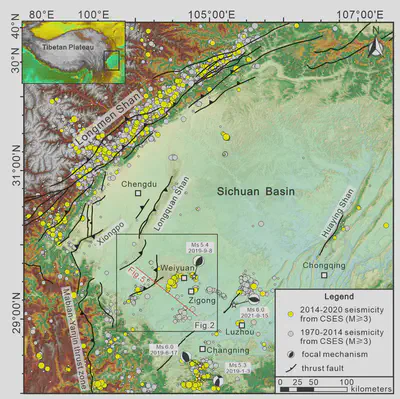
Figure 1. Topography map of the Longmen Shan and Sichuan Basin with major faults and cities. The red line indicates the location of seismic reflection profile PQ-92 in Fig. 5. The white pentagrams represent the MS 5.4 Weiyuan, MS 6.0 Luxian, MS 6.0 and 5.3 Changning respectively. The seismicity records from 1970 to 2014, and 2014 to 2020 are distinguished with grey and yellow circles, respectively. The earthquake data were obtained from the China Earthquake Networks Center, http://www.ceic.ac.cn/history in Chinese.
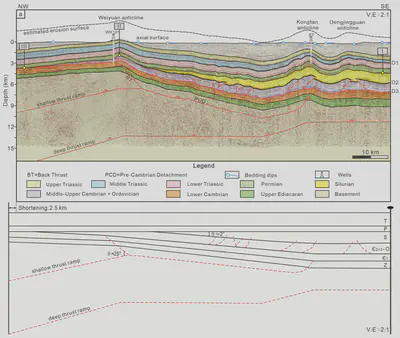
Figure 5. (a) Structural interpretation of seismic reflection profile PQ-92 across the region of the Weiyuan to Dengjingguan anticlines, with wells K7 and WH101 constraining the horizons, are shown. (b) Restoration results of deformed horizons from Weiyuan to Dengjingguan anticlines. The shortening of the base of the Jurassic layer in a representative structural profile is 2.5 km. The Cenozoic sedimentary strata within this area in the profile are absent. The profile is shown at 2X vertical exaggeration. BT: back thrust; PCD: pre-Cambrian detachment; D1: Middle Triassic detachment; D2: Lower Silurian detachment; D3: Mid-Upper Cambrian detachment.

Figure 6. Schematic representation of the experimental setup. (a) The initial model setup contained homogeneous mechanical properties. (b) The contractional wedge model setup contained two-level basal detachments and three detachments in sedimentary cover, the wedge point occurs within the basement. (c) The shallow thrust ramp merged with an east-dipping detachment fault at the wedge point. BT: back thrust; PCD: pre-Cambrian detachment.
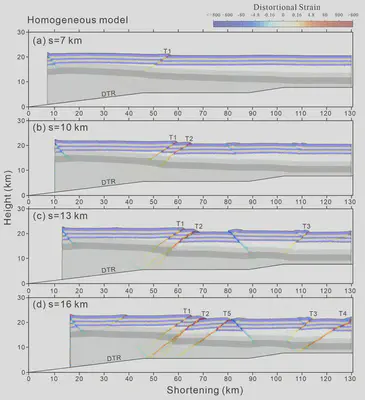
Figure 7. Progressive evolution observed in homogeneous model, with distortional strains superimposed on the colored strata. (a)–(d) The results of the model at total shortenings of 7 km (a), 10 km (b), 13 km (c), and 16 km (d). F1–F5 denote thrust faults in the order of their formation. DTR: deep thrust ramp.
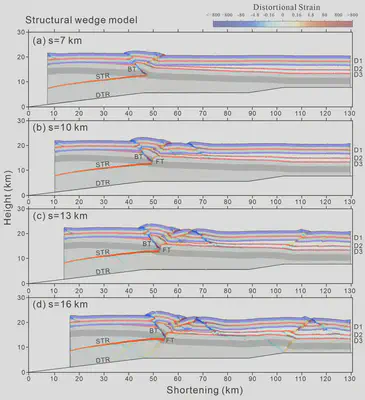
Figure 8. Progressive evolution observed in contractional wedge model, with distortional strains superimposed on the colored strata. (a)–(d) The results of the model at total shortenings of 7 km (a), 10 km (b), 13 km (c), and 16 km (d). BT: back thrust; FT: fore thrust; STR: shallow thrust ramp; DTR: deep thrust ramp; D1: Middle Triassic detachment; D2: Lower Silurian detachment; D3: Mid-Upper Cambrian detachment.
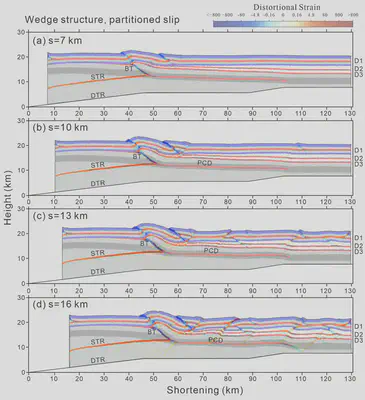
Figure 10. Progressive evolution observed in the partitioned slipping wedge model, with distortional strains superimposed on the colored strata. (a)–(d) The results of the model at total shortenings of 7 km (a), 10 km (b), 13 km (c), and 16 km (d). BT: back thrust; PCD: pre-Cambrian detachment; STR: shallow thrust ramp; DTR: deep thrust ramp; D1: Middle Triassic detachment; D2: Lower Silurian detachment; D3: Mid-Upper Cambrian detachment.
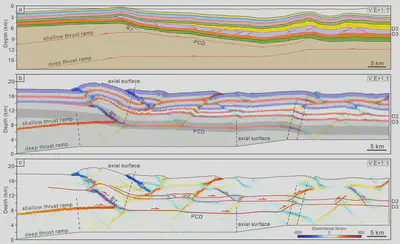
Figure 11. Comparison between the structural cross-section of the Weiyuan to Kongtan anticlines and the result of the partitioned slipping wedge model. (a) Interpreted seismic profile in Figure 5. (b, c) The result of the partitioned slipping model when the shortening amount is 16 km, graph with distortional strains superimposed on the colored strata (b), graph only with distortional strains (c). BT: back thrust; PCD: pre-Cambrian detachment; D2: lower Silurian detachment; D3: mid-upper Cambrian detachment.
Conclusions
Combined with structural interpretation, DEM simulations, and 3-D modeling, this study revealed the structure, kinematics, and mechanical evolution of a preexisting basement-involved structural wedge beneath the Weiyuan anticline and multiple detachments of the sedimentary cover in the southwestern Sichuan foreland fold-and-thrust belt, China, and discussed their influences on induced seismicity. Based on our study results, the following conclusions were drawn: (1)The Weiyuan anticline is formed by a preexisting basement-involved contractional wedge consisting of a basal thrust ramp and a back thrust fault. East of the Weiyuan limb, the fault slip continued to propagate along the Cambrian detachment, contributing to the development of extensive low-displacement thrusts that cut through the Silurian shale detachment. (2) The earthquakes induced in the Weiyuan block were primarily controlled by preexisting compressional basement-involved thrust structures and multi-level detachments in the sedimentary cover. The largest induced earthquake (2019 ML 5.2 event), along with other M > 4 earthquakes, occurred on BT within the basement-involved wedge structure. (3) In the sedimentary cover, induced earthquakes (M < 4) primarily occurred between the Silurian shale and the middle–upper Cambrian shale detachments. Densely developed thrust faults connect the high-pore-pressure Silurian shale with Cambrian shale detachment, promoting the downward diffusion of pore pressure, which enhances the occurrence of induced earthquakes.
Acknowledgments
We thank Editor‐in‐Chief Taylor Schildgen, Associate Editor Judith Hubbard, reviewer Andreas Plesch, and one anonymous reviewer for their comments and suggestions.This research was supported by the National Natural Science Foundation of China (42172232 and 41702202) and National Key R&D Program of China (2021YFC3000604). Numerical simulations were performed on the discrete element modeling software VBOX (www.geovbox.com/en). The authors thank Prof. Julia Morgan from Rice University for generously sharing her discrete element code (RICEBAL v5.4) and post-processing scripts and algorithms, which have been used to process and display the model outputs presented in our modeling. The numerical simulation of this study is performed on the computing facilities in the High-Performance Computing Center (HPCC) of Nanjing University.
Data Availability Statement
We used VBOX version 2.1 ( Li et al., 2021 ; https://geovbox.com/en/) for the discrete-element method (DEM) numerical simulations. The web site https://geovbox.com/en/ provides manual and tutorial, examples, and references for VBOX version 2.1. The code for our DEM experiments can be obtained from Open Science Framework (https://osf.io/9hn74/). The relocated seismicity data used in this study is provided by Zi et al. (2023). The seismic reflection data, drilling wells, and structural maps were provided courtesy of the Southwest Oil and Gas Field Company, PetroChina. They cannot be released to the public. 3D models after time to depth conversion, including Middle-Upper Cambrian detachment, Lower Silurian detachment, and main faults, can also be obtained from Open Science Framework (https://osf.io/9hn74/).